Spatiotemporal Evolution and Driving Mechanisms of Coupling Coordination Between Green Innovation Efficiency and Urban Ecological Resilience: Evidence from Yangtze River Delta, China
Abstract
1. Introduction
2. Materials
2.1. Study Area
2.2. Data
2.3. Index System Construction
2.3.1. Green Innovation Efficiency (GIE) Evaluation Framework
2.3.2. Urban Ecological Resilience (UER) Evaluation Framework
- The pressure subsystem quantifies the stress intensity of socioeconomic activities on the ecosystem. Indicators like per capita industrial wastewater discharge are selected to directly reflect the pressure-bearing capacity characterizing the system’s risk.
- The state subsystem assesses the real-time health level of the ecosystem’s structure and function. Metrics like built-up area green coverage rate and wetland area change rate capture the system’s efficacy in preserving stability and functional continuity during disturbances.
- The response subsystem measures socio-technical interventions against ecological risks. Its distinctive feature is the systematic integration of green technology innovation as a driving force. Specifically, this subsystem quantifies the effectiveness of pollution control technologies such as per capita industrial SO2 removal and the implementation level of resource circulation technologies such as centralized sewage treatment rate.
3. Methodologies
3.1. Super-SBM DEA Model
3.2. Entropy Weight Method
3.3. Coupling Coordination Model
3.4. Spatial Auto-Correlation
3.5. Geodetector Model
3.6. Spatiotemporal Weighted Regression
4. Results
4.1. Analyzing the Spatiotemporal Evolution of Green Innovation Efficiency (GIE)
4.2. Analyzing the Spatiotemporal Evolution of Urban Ecological Resilience (UER)
4.3. Analyzing the Spatiotemporal Evolution of the Coupling Coordination Degree (CCD)
5. Spatial Heterogeneity of Driving Mechanisms for Coupling Coordination Degree (CCD) Evolution
5.1. Spatial Correlation of Coupling Coordination Degree (CCD)
5.2. Dominant Drivers of the Coupling Coordination Degree (CCD) Identified by Geodetector
5.3. Spatiotemporal Non-Stationarity of Coupling Coordination Degree (CCD) via GTWR
6. Discussion
6.1. Thematic Comparison with Prior Research
6.2. Policy Implication
6.2.1. Differentiated Governance Strategies for Spatial Mismatch and Typologies
6.2.2. Targeted Interventions for Driver-Specific Heterogeneity
6.2.3. Adaptive Management for System Vulnerability
7. Conclusions
Supplementary Materials
Funding
Institutional Review Board Statement
Informed Consent Statement
Data Availability Statement
Conflicts of Interest
Abbreviations
| GIE | Green innovation efficiency |
| UER | Urban ecological resilience |
| CCD | Coupling coordination degree |
| YRD | Yangtze River Delta |
| GTWR | Geographically and Temporally Weighted Regression |
| UNDRR | The United Nations Office for Disaster Risk Reduction |
| UNEP | United Nations Environment Programme |
| PSR | Pressure–State–Response |
| GWR | Geographically Weighted Regression |
| Super-SBM DEA | Super-Slack-Based Measure Data Envelopment Analysis |
Appendix A. Classification Criteria for Coupling Coordination Degree (CCD)
| C | Coupling Phase | Coupling Specification | D | Coordination Level |
| (0.0, 0.3] | Low coupling | Coupling gradually | (0.0, 0.1] | Extremely discordant |
| (0.1, 0.2] | Severely discordant | |||
| (0.2, 0.3] | Moderately discordant | |||
| (0.3, 0.6] | Antagonism | Certain degree of development | (0.3, 0.4] | Mildly discordant |
| (0.4, 0.5] | Borderline discordant | |||
| (0.5, 0.6] | Barely coordinated | |||
| (0.6, 0.8] | Running-in | Good coupling development | (0.6, 0.7] | Primary coordination |
| (0.7, 0.8] | Intermediate coordination | |||
| (0.8, 1.0] | High coupling | Mutually reinforcing development | (0.8, 0.9] | Well-coordinated |
| (0.9, 1.0] | Highly coordinated |
References
- Jaung, W.; Carrasco, L.; Richards, D.; Ahmad, S.; Tan, P. The role of urban nature experiences in sustainable consumption: A transboundary urban ecosystem service. Environ. Dev. Sustain. 2023, 25, 601–621. [Google Scholar] [CrossRef]
- Nina, E.; Pan, H. Policy nexus for urban resilience and nature-based solutions. Nat. Based Solut. Sustain. Dev. Goals 2025, 111–125. [Google Scholar] [CrossRef]
- Xu, X.; Wang, M.; Wang, M. The coupling coordination degree of economic, social and ecological resilience of urban agglomerations in China. Int. J. Environ. Res. Public Health 2022, 20, 413. [Google Scholar] [CrossRef]
- Meerow, S.; Stults, M. Comparing conceptualizations of urban climate resilience in theory and practice. Sustainability 2016, 8, 701. [Google Scholar] [CrossRef]
- Folke, C. Resilience (Republished). Ecol. Soc. 2016, 21, 44. [Google Scholar] [CrossRef]
- Ravita, D.; Devesh, A.; Semaan, S.; Rayash, K. Beyond energy access: How renewable energy fosters resilience in island communities. Resources 2025, 14, 20. [Google Scholar] [CrossRef]
- Han, X.; Yu, J.; Shi, L.; Zhao, X.; Wang, J. Spatiotemporal evolution of ecosystem service values in an area dominated by vegetation restoration: Quantification and mechanisms. Ecol. Indic. 2021, 131, 108191. [Google Scholar] [CrossRef]
- Weber, P.; Kassab, E.; Ruanguttamanun, C. Sustainable development and green innovation: The role of green dynamic capabilities. Int. J. Innov. Res. Sci. Stud. 2025, 8, 1075–1089. [Google Scholar] [CrossRef]
- Zhang, X.; Niu, Y.; Si, D.; Xiao, Z. Regulatory greening: The impact of environmental legislation on corporate green innovation. Econ. Anal. Policy 2024, 82, 359–376. [Google Scholar] [CrossRef]
- Zeng, J.; Kare, M.; Lafont, J. The co-integration identification of green innovation efficiency in Yangtze River Delta region. J. Bus. Res. 2021, 134, 252–262. [Google Scholar] [CrossRef]
- Hua, S.; Li, J.; Pan, Y.; Pan, F. Green technology innovation spillover effect and urban eco-efficiency convergence: Evidence from Chinese cities. Energy Econ. 2022, 114, 106307. [Google Scholar] [CrossRef]
- Liu, G. Evaluating the regional green innovation efficiency in China: A DEA-Malmquist productivity index approach. Appl. Mech. Mater. 2015, 733, 355–362. [Google Scholar] [CrossRef]
- Li, M.; Lin, S.; Chen, Y. The evaluation, dynamic evolutionary characteristics and influencing factors of green innovation efficiency in China. Pol. J. Environ. Stud. 2025, 34, 1607–1619. [Google Scholar] [CrossRef]
- Tone, K. Slacks-based measure of efficiency in data envelopment analysis. Eur. J. Oper. Res. 2001, 130, 498–509. [Google Scholar] [CrossRef]
- Yuan, Z.; Lan, Y.; Zhuo, Q.; Hsu, S. Innovating for a greener future: Novelty in green patents and its impact on sustainable development goals in China’s construction sector. Resources 2025, 213, 108025. [Google Scholar] [CrossRef]
- Abdildin, Y.; Nurkenov, S.; Kerimray, A. Analysis of green technology development in Kazakhstan. Int. J. Energy Econ. Policy 2021, 11, 269–279. [Google Scholar] [CrossRef]
- Wang, C. How does manufacturing agglomeration affect urban ecological resilience? Evidence from the Yangtze River Delta region of China. Front. Environ. Sci. 2024, 12, 1492866. [Google Scholar] [CrossRef]
- Liu, J.; Wang, X.; Gao, G. Spatiotemporal evolution and determinants of urban flood resilience: A case study of Yellow River Basin. Sustainability 2025, 17, 1433. [Google Scholar] [CrossRef]
- Zhu, Q.; Van, B.; Wang, Z.; Yang, S. Bed-level changes on intertidal wetland in response to waves and tides: A case study from the Yangtze River Delta. Mar. Geol. 2017, 385, 160–172. [Google Scholar] [CrossRef]
- Jia, Q.; Jiao, L.; Hu, X. Telecoupling indirect ecological impacts of urban expansion in China from the perspective of the food trade. Land Degrad. Dev. 2023, 34, 4964–4976. [Google Scholar] [CrossRef]
- Liao, Z.; Zhang, L. Analyzing and predicting the urbanization and ecological resilience coupling and coordination of Guangdong Province. Palgrave Commun. 2024, 11, 1322. [Google Scholar] [CrossRef]
- Lan, C.; Li, X.; Peng, B.; Li, X. Unlocking urban ecological resilience: The dual role of environmental regulation and green technology innovation. Sustain. Cities Soc. 2025, 128, 106466. [Google Scholar] [CrossRef]
- Li, F.; Wu, S.; Liu, H.; Yan, D. Biodiversity loss through cropland displacement for urban expansion in China. Sci. Total Environ. 2024, 907, 167988. [Google Scholar] [CrossRef]
- Fu, S.; Liu, J.; Wang, J.; Tian, J.; Li, X. Enhancing urban ecological resilience through integrated green technology progress: Evidence from Chinese cities. Environ. Sci. Pollut. 2024, 31, 36349–36366. [Google Scholar] [CrossRef]
- Dong, F.; Zhu, J.; Li, Y.; Chen, Y.; Gao, Y.; Hu, M.; Qin, C.; Sun, J. How green technology innovation affects carbon emission efficiency: Evidence from developed countries proposing carbon neutrality targets. Environ. Sci. Pollut. Res. 2022, 29, 35780–35799. [Google Scholar] [CrossRef] [PubMed]
- Kates, R.; Travis, W.; Wilbanks, T. Transformational adaptation when incremental adaptations to climate change are insufficient. Proc. Natl. Acad. Sci. USA 2012, 109, 7156–7161. [Google Scholar] [CrossRef] [PubMed]
- Bergek, A.; Hekkert, M.; Jacobsson, S. Technological innovation systems in contexts: Conceptualizing contextual structures and interaction dynamics. Environ. Innov. Soc. Transit. 2015, 16, 51–64. [Google Scholar] [CrossRef]
- Serra, V.; Defraia, S.; Ledda, A.; Calia, G.; Corona, F.; De, M.; Mulas, M. Ecological network, ecosystem services, and green infrastructure planning: A method for the metropolitan city of Cagliari, Italy. Netw. Spat. Econ. 2025, 25, 95–120. [Google Scholar] [CrossRef]
- Shu, C.; Bi, H.; Meng, G.; Cao, J.; Wu, J. Research on spatial-temporal heterogeneity of driving factors of green innovation efficiency in Yangtze River Delta urban agglomeration—Empirical test based on the Geographically Weighted Regression model. Front. Energy Res. 2024, 12, 1308494. [Google Scholar]
- Yang, Y.; Rao, H. Coordinated development of the tourism industry and ecological environment: A case study of hubei province in China. Pol. J. Environ. Stud. 2024, 33, 4903–4915. [Google Scholar] [CrossRef]
- Zhao, S.; Li, Z.; Deng, H.; You, X.; Tong, J.; Yuan, B.; Zeng, Z. Spatial-temporal evolution characteristics and driving factors of carbon emission prediction in China-research on ARIMA-BP neural network algorithm. Front. Environ. Sci. 2024, 12, 1497941. [Google Scholar] [CrossRef]
- Wang, J.; Huang, X.; Sun, D.; Xu, R. Government department merger, perception of administrative barriers, and corporate investment: Evidence from China’s State Administration for Market Regulation. Financ. Res. Lett. 2024, 67, 105788. [Google Scholar] [CrossRef]
- Diakoulaki, D.; Mavrotas, G.; Papayan, L. Determining objective weights in multiple criteria problems: The critic method. Comput. Oper. Res. 1995, 22, 763–770. [Google Scholar] [CrossRef]
- Yao, Z.; Huang, G. Adaptability comparison of climate downscaling methods and future climate projections in the Pearl River Delta, China. Nat. Hazards 2025, 121, 4703–4729. [Google Scholar] [CrossRef]
- Zhang, T.; Li, L. Research on temporal and spatial variations in the degree of coupling coordination of tourism–urbanization–ecological environment: A case study of Heilongjiang, China. Environ. Dev. Sustain. 2021, 23, 8474–8491. [Google Scholar] [CrossRef]
- Gai, M.; Qin, B.; Zhen, X. Evolution analysis of the spatial-temporal pattern of coupling and coordination between the transformation of economic growth momentum and green development. Geogr. Res. 2021, 40, 2572–2590. [Google Scholar]
- Wang, J.; Xu, C. Geodetector: Principle and prospective. Acta Geogr. Sin. 2017, 72, 116–134. [Google Scholar]
- Li, F.; Nan, T.; Zhang, H.; Luo, K.; Xiang, K.; Peng, Y. Evaluating ecological vulnerability and its driving mechanisms in the Dongting Lake region from a multi-method integrated perspective: Based on Geodetector and explainable machine learning. Land 2025, 14, 1435. [Google Scholar] [CrossRef]
- Cong, X.; Li, X.; Gong, Y. Spatiotemporal evolution and driving forces of sustainable development of urban human settlements in China for SDGs. Land 2021, 10, 993. [Google Scholar] [CrossRef]
- Wang, Y.; Chen, X.; Ibra, R.; Faryan, A. Unveiling the criticality of digitalization, eco-innovation, carbon tax, and environmental regulation in G7 quest for carbon footprint mitigation: Insights for sustainable development. Nat. Resour. Forum 2024, 49, 1284–1307. [Google Scholar] [CrossRef]
- He, Q.; Deng, X.; Li, C.; Yan, Z. Can environmental centralization help reduce pollution? Evidence from an empirical study in China. Emerg. Mark. Financ. Trade 2020, 56, 3523–3546. [Google Scholar]
- Wang, K.; Yin, H.; Chen, Y. The effect of environmental regulation on air quality: A study of new ambient air quality standards in China. J. Clean. Prod. 2019, 215, 268–279. [Google Scholar] [CrossRef]
- Chen, Y.; Jiang, C.; Peng, L.; Zhao, S.; Chen, C. Digital infrastructure construction and urban industrial chain resilience: Evidence from the “Broadband China” strategy. Sustain. Cities Soc. 2025, 121, 106228. [Google Scholar] [CrossRef]
- Meerow, S.; Newell, J.; Stults, M. Defining urban resilience: A review. Landsc. Urban Plan. 2016, 147, 38–49. [Google Scholar] [CrossRef]
- Cheng, H. The coordinated relationship between urban resilience and tourism development in the urban agglomeration of Yangtze River Delta. J. Shaanxi Norm. Univ. 2023, 51, 59–70. [Google Scholar]
- Xu, S.; Li, B.; Shen, Z. Can the digital economy enhance ecological resilience-Based on empirical data from 53 cities in the Yellow River Basin of China. Pol. J. Environ. Stud. 2024, 33, 4851–4859. [Google Scholar] [CrossRef]
- Huo, B.; Wang, B.; Li, Z. How to deal with technological turbulence for improving innovation performance. Technol. Anal. Strateg. Manag. 2024, 36, 549–562. [Google Scholar] [CrossRef]
- Triyanti, A.; Surtiari, G.; Lassa, J.; Rafliana, I.; Hanifa, N.; Muhidin, M.; Djalante, R. Governing systemic and cascading disaster risk in Indonesia: Where do we stand and future outlook. Disaster Prev. Manag. 2022, 32, 27–48. [Google Scholar] [CrossRef]
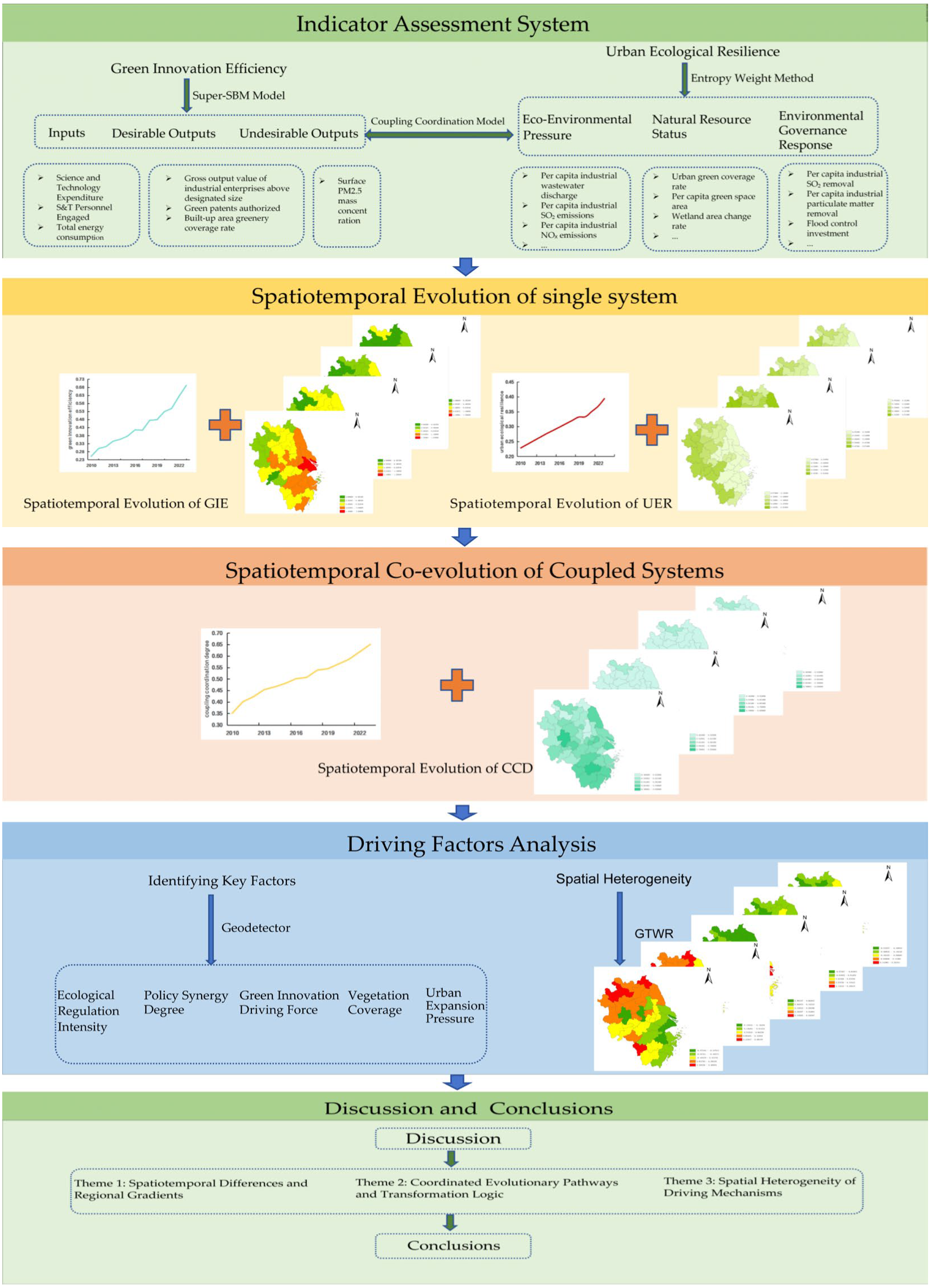
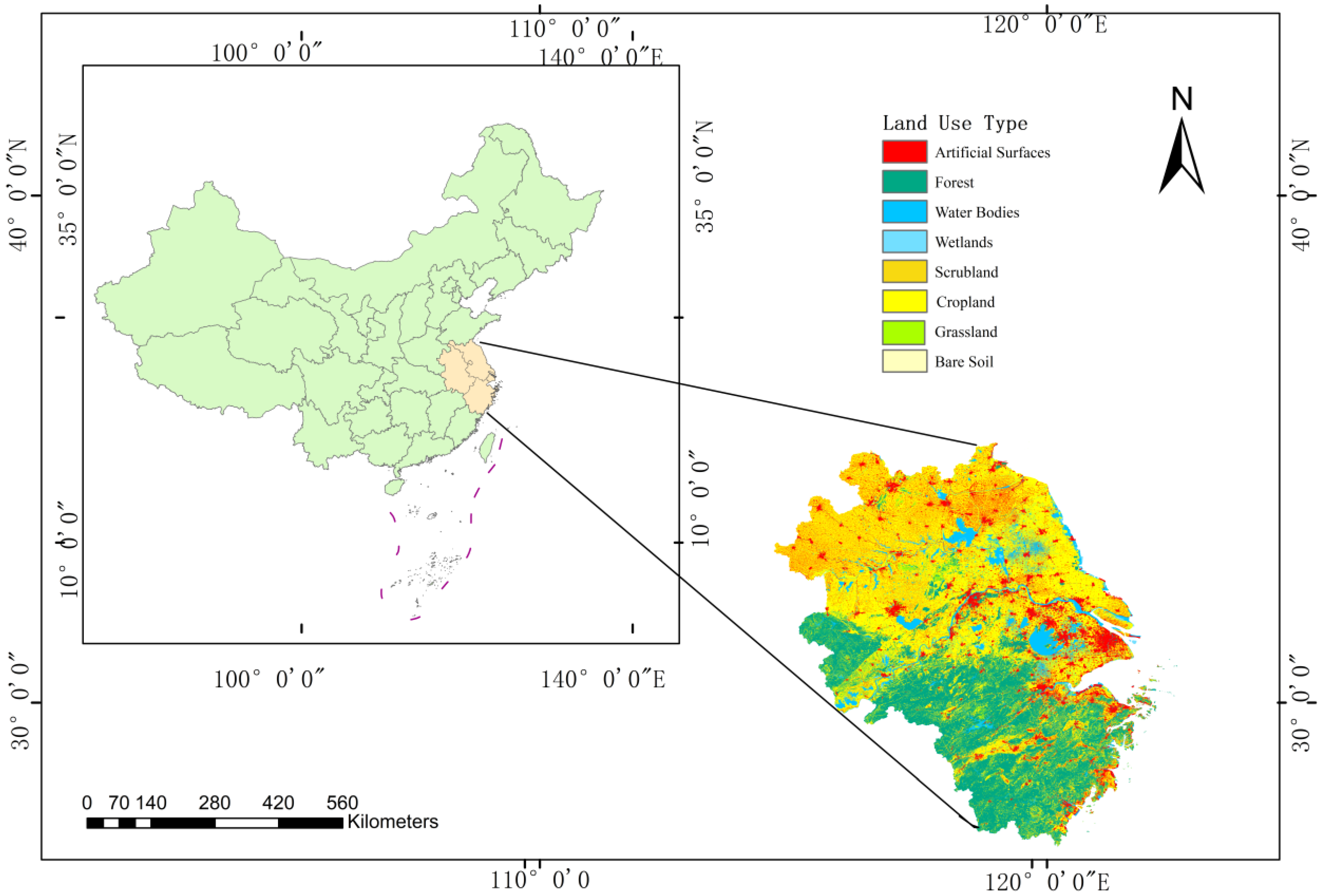


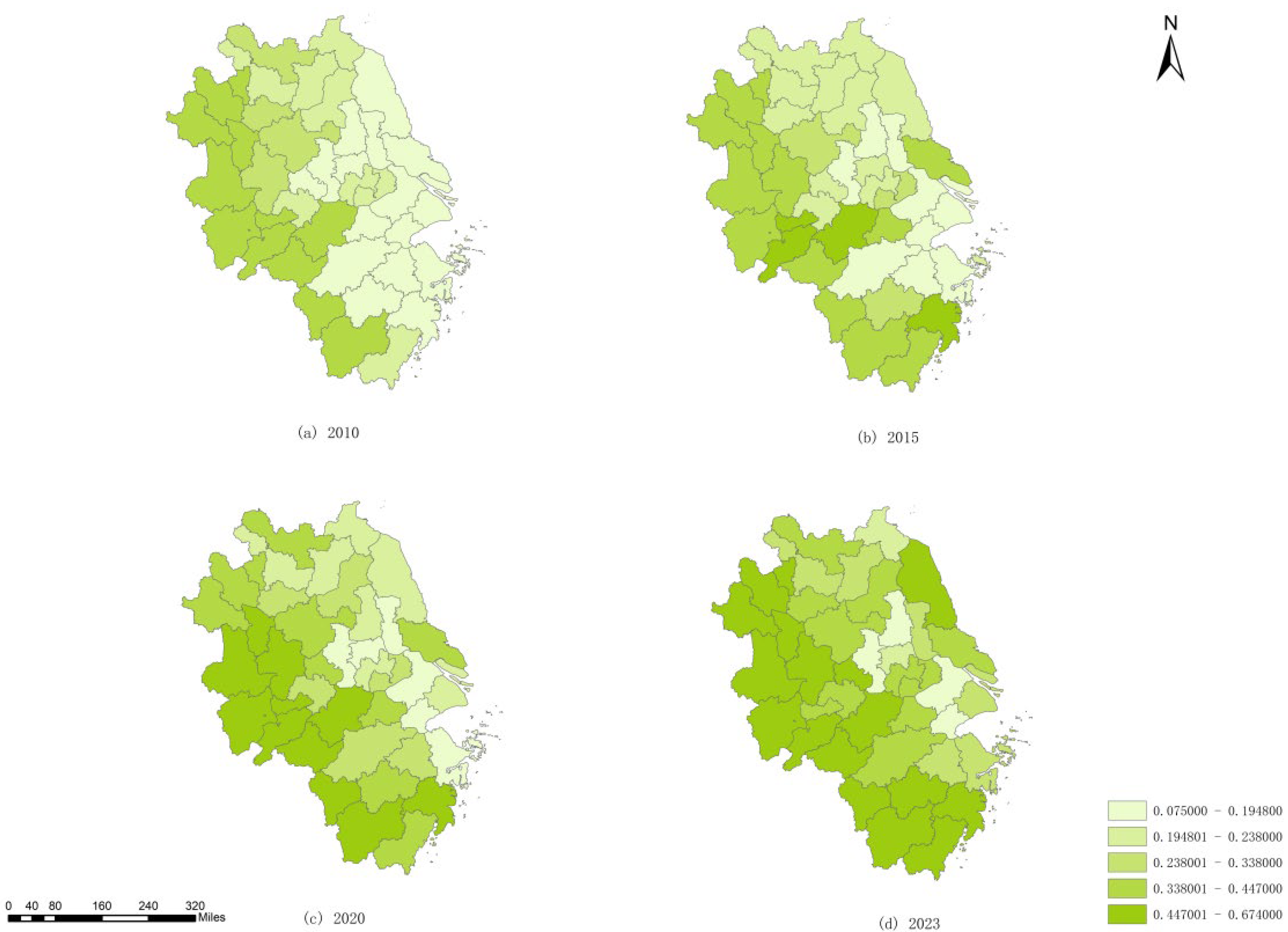
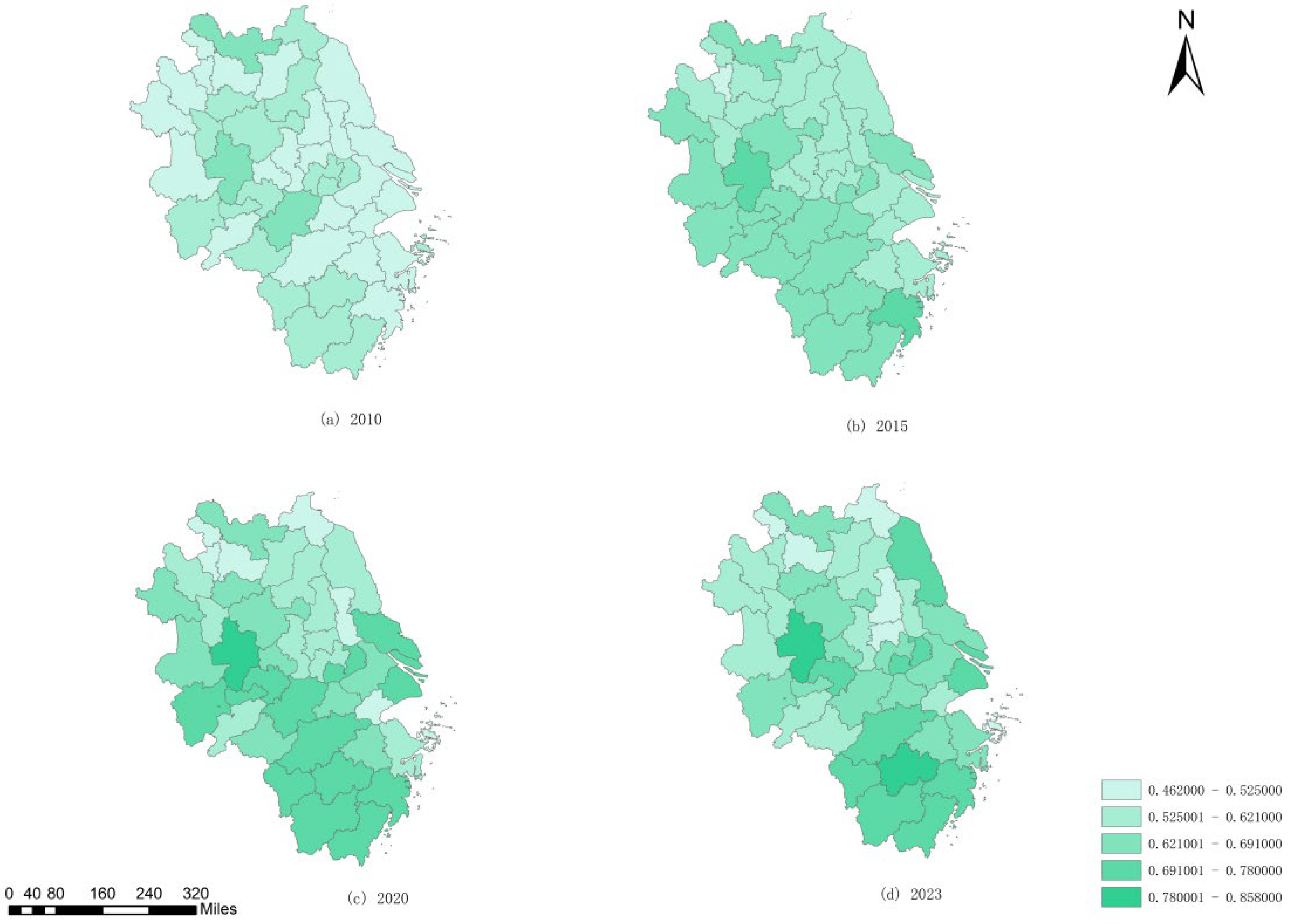
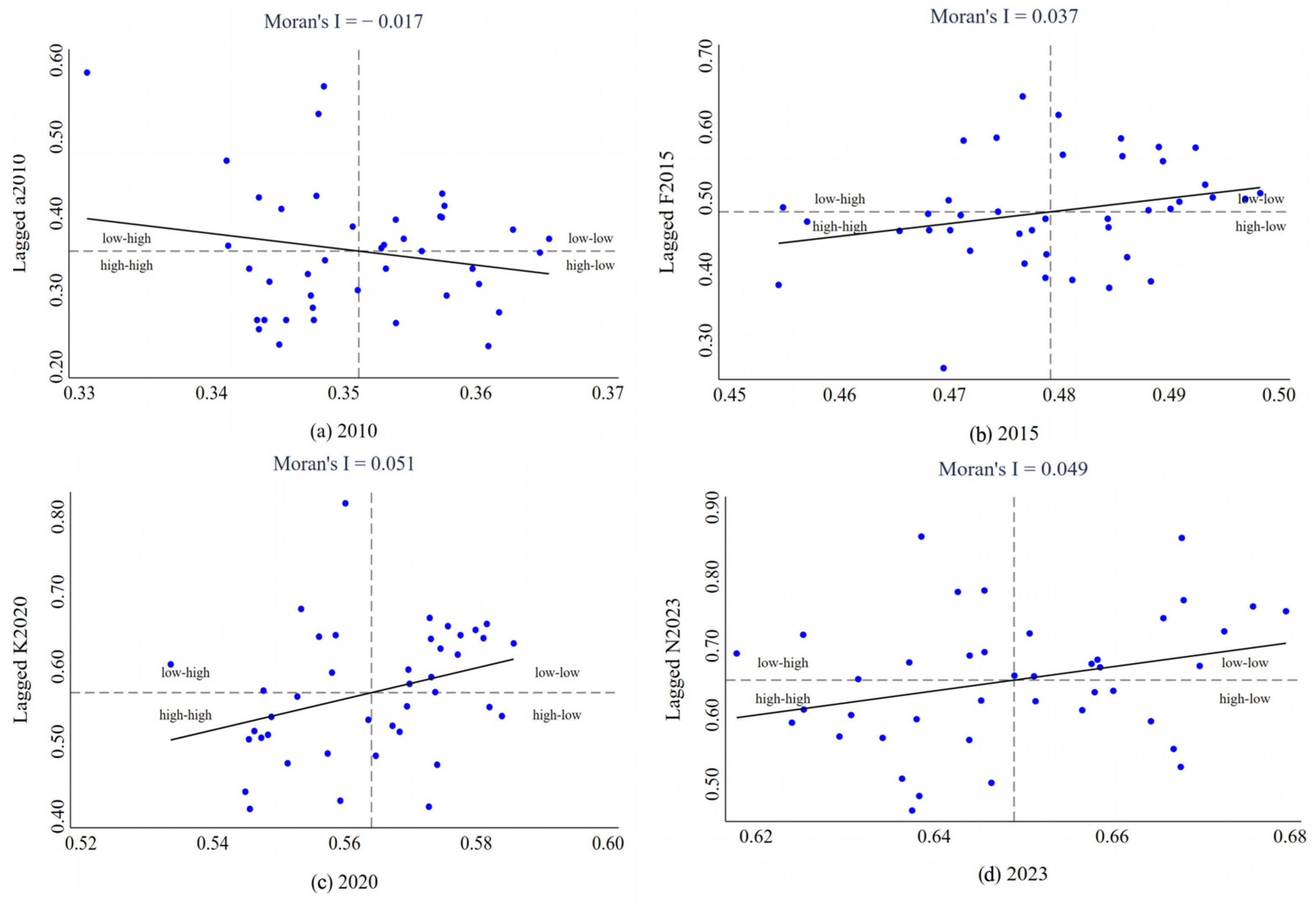
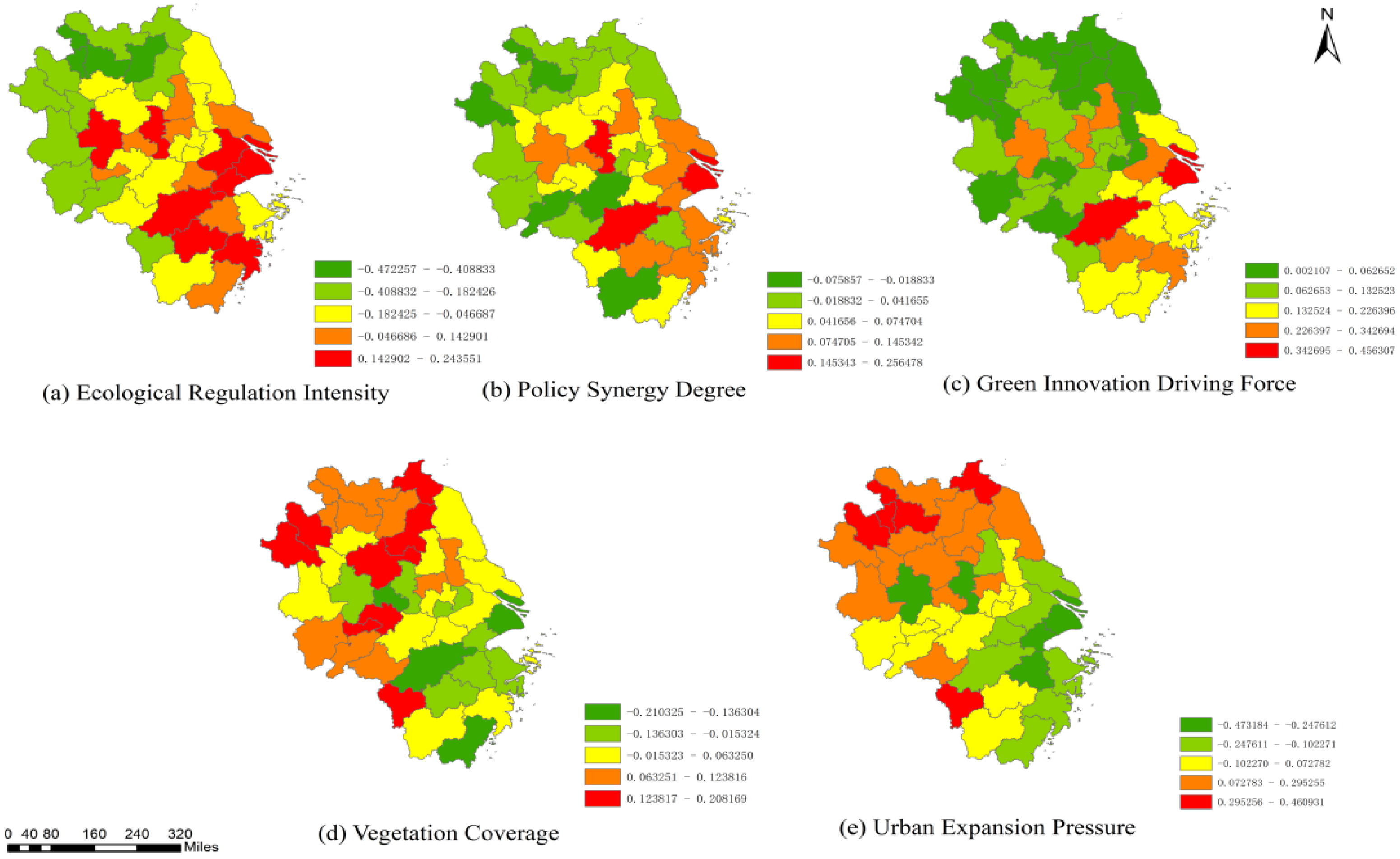
| System | Primary Index | Variables and Interpretation | Code | Positive/ Negative |
|---|---|---|---|---|
| Green innovation efficiency (U1) | Inputs (U11) | Science and technology expenditure (CYN 10,000) | x11 | + |
| Science and technology personnel engaged (10,000 persons) | x12 | + | ||
| Total energy consumption (10,000 tons of SCE) | x13 | − | ||
| Desirable outputs (U12) | Gross output value of industrial enterprises above designated size (CYN 10,000) | x14 | + | |
| Green patents authorized (items) | x15 | + | ||
| Built-up area greenery coverage rate (%) | x16 | + | ||
| Undesirable outputs (U13) | Surface PM2.5 mass concentration (μg/m3) | x17 | − | |
| Urban ecological resilience (U2) | Eco-environmental pressure (U21) | Per capita industrial wastewater discharge (10,000 tons/capita) | x21 | − |
| Per capita industrial SO2 emissions (tons/capita) | x22 | − | ||
| Per capita industrial particulate matter emissions (tons/capita) | x23 | − | ||
| Per capita industrial NOx emissions (tons/capita) | x24 | − | ||
| Natural resource status (U22) | Urban green coverage rate (%) | x25 | + | |
| Per capita green space area (m2/capita) | x26 | + | ||
| Per capita total water resources (m3/capita) | x27 | + | ||
| Per capita built-up area (m2/capita) | x28 | − | ||
| Per capita urban road area (m2/capita) | x29 | + | ||
| Wetland area change rate (%) | x210 | + | ||
| Environmental governance response (U23) | Per capita industrial SO2 removal (tons/capita) | x211 | + | |
| Per capita industrial particulate matter removal (tons/capita) | x212 | + | ||
| Comprehensive utilization rate of industrial solid waste (%) | x213 | + | ||
| Centralized sewage treatment rate (%) | x214 | + | ||
| Flood control investment (%) | x215 | + |
| 2010 | 2011 | 2012 | 2013 | 2014 | 2015 | 2016 | 2017 | 2018 | 2019 | 2020 | 2021 | 2022 | 2023 | |
|---|---|---|---|---|---|---|---|---|---|---|---|---|---|---|
| Moran’s I | −0.017 | 0.004 | 0.016 | 0.038 | 0.042 | 0.037 | 0.027 | 0.010 | 0.053 | 0.059 | 0.051 | 0.045 | 0.049 | 0.049 |
| Z | 0.386 | 1.301 | 1.871 | 2.884 | 3.044 | 2.829 | 2.443 | 1.596 | 3.625 | 3.844 | 3.493 | 3.167 | 3.354 | 3.362 |
| p | 0.350 | 0.097 | 0.031 | 0.002 | 0.001 | 0.002 | 0.007 | 0.055 | 0.000 | 0.000 | 0.000 | 0.001 | 0.000 | 0.000 |
| Influencing Factor | Indicator Description | Unit |
|---|---|---|
| Ecological regulation intensity (x1) | Density of environmental regulation policies | cases/year |
| Policy synergy degree (x2) | Similarity of policy texts | % |
| Green innovation driving force (x3) | Share of green R&D expenditure in GDP | % |
| Vegetation coverage (x4) | Vegetation coverage | % |
| Urban expansion pressure (x5) | Annual expansion rate of built-up area | % |
| 2010 | 2015 | 2020 | 2023 | Mean q-Value | Explanatory Power Ranking | |
|---|---|---|---|---|---|---|
| Ecological regulation intensity (x1) | 0.239 | 0.044 | 0.339 | 0.175 | 0.199 | 3 |
| Policy synergy degree (x2) | 0.249 | 0.292 | 0.205 | 0.249 | 0.249 | 2 |
| Green innovation driving force(x3) | 0.249 | 0.336 | 0.341 | 0.322 | 0.312 | 1 |
| Vegetation coverage (x4) | 0.047 | 0.260 | 0.106 | 0.284 | 0.174 | 4 |
| Urban expansion pressure (x5) | 0.138 | 0.164 | 0.254 | 0.085 | 0.160 | 5 |
Disclaimer/Publisher’s Note: The statements, opinions and data contained in all publications are solely those of the individual author(s) and contributor(s) and not of MDPI and/or the editor(s). MDPI and/or the editor(s) disclaim responsibility for any injury to people or property resulting from any ideas, methods, instructions or products referred to in the content. |
© 2025 by the author. Licensee MDPI, Basel, Switzerland. This article is an open access article distributed under the terms and conditions of the Creative Commons Attribution (CC BY) license (https://creativecommons.org/licenses/by/4.0/).
Share and Cite
Yang, S. Spatiotemporal Evolution and Driving Mechanisms of Coupling Coordination Between Green Innovation Efficiency and Urban Ecological Resilience: Evidence from Yangtze River Delta, China. Sustainability 2025, 17, 8528. https://doi.org/10.3390/su17198528
Yang S. Spatiotemporal Evolution and Driving Mechanisms of Coupling Coordination Between Green Innovation Efficiency and Urban Ecological Resilience: Evidence from Yangtze River Delta, China. Sustainability. 2025; 17(19):8528. https://doi.org/10.3390/su17198528
Chicago/Turabian StyleYang, Shu. 2025. "Spatiotemporal Evolution and Driving Mechanisms of Coupling Coordination Between Green Innovation Efficiency and Urban Ecological Resilience: Evidence from Yangtze River Delta, China" Sustainability 17, no. 19: 8528. https://doi.org/10.3390/su17198528
APA StyleYang, S. (2025). Spatiotemporal Evolution and Driving Mechanisms of Coupling Coordination Between Green Innovation Efficiency and Urban Ecological Resilience: Evidence from Yangtze River Delta, China. Sustainability, 17(19), 8528. https://doi.org/10.3390/su17198528





